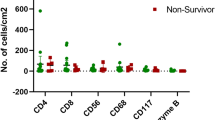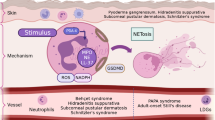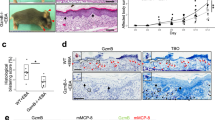Abstract
Stevens-Johnson syndrome (SJS) and toxic epidermal necrolysis (TEN) are life-threatening adverse drug reactions characterized by massive epidermal necrosis, in which the specific danger signals involved remain unclear. Here we show that blister cells from skin lesions of SJS-TEN primarily consist of cytotoxic T lymphocytes (CTLs) and natural killer (NK) cells, and both blister fluids and cells were cytotoxic. Gene expression profiling identified granulysin as the most highly expressed cytotoxic molecule, confirmed by quantitative PCR and immunohistochemistry. Granulysin concentrations in the blister fluids were two to four orders of magnitude higher than perforin, granzyme B or soluble Fas ligand concentrations, and depleting granulysin reduced the cytotoxicity. Granulysin in the blister fluids was a 15-kDa secretory form, and injection of it into mouse skin resulted in features mimicking SJS-TEN. Our findings demonstrate that secretory granulysin is a key molecule responsible for the disseminated keratinocyte death in SJS-TEN and highlight a mechanism for CTL- or NK cell—mediated cytotoxicity that does not require direct cellular contact.
This is a preview of subscription content, access via your institution
Access options
Subscribe to this journal
Receive 12 print issues and online access
$209.00 per year
only $17.42 per issue
Buy this article
- Purchase on Springer Link
- Instant access to full article PDF
Prices may be subject to local taxes which are calculated during checkout






Similar content being viewed by others
References
Gomes, E.R. & Demoly, P. Epidemiology of hypersensitivity drug reactions. Curr. Opin. Allergy Clin. Immunol. 5, 309–316 (2005).
Roujeau, J.C. & Stern, R.S. Severe adverse cutaneous reactions to drugs. N. Engl. J. Med. 331, 1272–1285 (1994).
Roujeau, J.C. The spectrum of Stevens-Johnson syndrome and toxic epidermal necrolysis: a clinical classification. J. Invest. Dermatol. 102, 28S–30S (1994).
Paul, C. et al. Apoptosis as a mechanism of keratinocyte death in toxic epidermal necrolysis. Br. J. Dermatol. 134, 710–714 (1996).
Roujeau, J.C. Immune mechanisms in drug allergy. Allergol. Int. 55, 27–33 (2006).
Nassif, A. et al. Drug specific cytotoxic T cells in the skin lesions of a patient with toxic epidermal necrolysis. J. Invest. Dermatol. 118, 728–733 (2002).
Nassif, A. et al. Toxic epidermal necrolysis: effector cells are drug-specific cytotoxic T cells. J. Allergy Clin. Immunol. 114, 1209–1215 (2004).
Chung, W.H. et al. Medical genetics: a marker for Stevens-Johnson syndrome. Nature 428, 486 (2004).
Hung, S.I. et al. HLA-B*5801 allele as a genetic marker for severe cutaneous adverse reactions caused by allopurinol. Proc. Natl. Acad. Sci. USA 102, 4134–4139 (2005).
Quinn, A.M. et al. Uncovering histologic criteria with prognostic significance in toxic epidermal necrolysis. Arch. Dermatol. 141, 683–687 (2005).
Viard, I. et al. Inhibition of toxic epidermal necrolysis by blockade of CD95 with human intravenous immunoglobulin. Science 282, 490–493 (1998).
Pereira, F.A., Mudgil, A.V. & Rosmarin, D.M. Toxic epidermal necrolysis. J. Am. Acad. Dermatol. 56, 181–200 (2007).
Abe, R. et al. Toxic epidermal necrolysis and Stevens-Johnson syndrome are induced by soluble Fas ligand. Am. J. Pathol. 162, 1515–1520 (2003).
Stur, K., Karlhofer, F.M. & Stingl, G. Soluble FAS ligand: a discriminating feature between drug-induced skin eruptions and viral exanthemas. J. Invest. Dermatol. 127, 802–807 (2007).
Brönnimann, M. & Yawalkar, N. Histopathology of drug-induced exanthems: is there a role in diagnosis of drug allergy? Curr. Opin. Allergy Clin. Immunol. 5, 317–321 (2005).
Chave, T.A., Mortimer, N.J., Sladden, M.J., Hall, A.P. & Hutchinson, P.E. Toxic epidermal necrolysis: current evidence, practical management and future directions. Br. J. Dermatol. 153, 241–253 (2005).
Gamen, S. et al. Granulysin-induced apoptosis. I. Involvement of at least two distinct pathways. J. Immunol. 161, 1758–1764 (1998).
Stenger, S. et al. An antimicrobial activity of cytolytic T cells mediated by granulysin. Science 282, 121–125 (1998).
Hanson, D.A., Kaspar, A.A., Poulain, F.R. & Krensky, A.M. Biosynthesis of granulysin, a novel cytolytic molecule. Mol. Immunol. 36, 413–422 (1999).
Krensky, A.M. & Clayberger, C. Granulysin: a novel host defense molecule. Am. J. Transplant. 5, 1789–1792 (2005).
Anderson, D.H. et al. Granulysin crystal structure and a structure-derived lytic mechanism. J. Mol. Biol. 325, 355–365 (2003).
Pardo, J. et al. A role of the mitochondrial apoptosis-inducing factor in granulysin-induced apoptosis. J. Immunol. 167, 1222–1229 (2001).
Deng, A. et al. Granulysin, a cytolytic molecule, is also a chemoattractant and proinflammatory activator. J. Immunol. 174, 5243–5248 (2005).
Peña, S.V., Hanson, D.A., Carr, B.A., Goralski, T.J. & Krensky, A.M. Processing, subcellular localization, and function of 519 (granulysin), a human late T cell activation molecule with homology to small, lytic, granule proteins. J. Immunol. 158, 2680–2688 (1997).
Ogawa, K. et al. Granulysin in human serum as a marker of cell-mediated immunity. Eur. J. Immunol. 33, 1925–1933 (2003).
Nagasawa, M. et al. Analysis of serum granulysin in patients with hematopoietic stem-cell transplantation: its usefulness as a marker of graft-versus-host reaction. Am. J. Hematol. 81, 340–348 (2006).
Balaji, K.N. et al. Surface cathepsin B protects cytotoxic lymphocytes from self-destruction after degranulation. J. Exp. Med. 196, 493–503 (2002).
Correia, O. et al. CD8+ lymphocytes in the blister fluid of severe acute cutaneous graft-versus-host disease: further similarities with toxic epidermal necrolysis. Dermatology 203, 212–216 (2001).
Acknowledgements
DH4 monoclonal antibody was a gift from A.M. Krensky (Stanford University). We thank H.-J. Lin, S.-J. Li, K.-H. Chen, L.-H. Lu of the Institute of Biomedical Sciences, Academia Sinica and members of the National Microarray & Gene Expression Analysis Core Facility, National Yang-Ming University, Taiwan, for excellent technical assistance. This work was supported by grants from the National Science Council, Taiwan (NSC95-2314-B-182A-048, 95-2314-B-010-096, 96-2320-B-010-021-MY2 and 96-2628-B-182A-065-MY2), Chang-Gung Memorial Hospital, Taiwan Ministry of Education (Aim for the Top University Plan, National Yang-Ming University), National Research Program for Genomic Medicine, Taiwan (National Clinical Core, NSC-95-3112-B-001-010 and National Genotyping Core, NSC-95-3112-B-001-011) and the Genomics and Proteomics Program, Academia Sinica.
Author information
Authors and Affiliations
Contributions
W.-H.C. and S.-I.H. designed and conducted the experiments and data analysis and wrote the manuscript. J.-Y.Y., C.-C.C., S.-C.C., H.-C.H., C.-H.Y. and C.-F.L. cared for the involved human subjects and provided clinical samples. S.-C.S., S.-P.H., C.-Y.W. and S.-W.C. performed experiments. J.-Y.W. and Y.-D.L. helped design the expression of protein. Y.-T.C. supervised the entire project and wrote the manuscript.
Corresponding author
Ethics declarations
Competing interests
W.-H.C., S.-I.H. amd Y.-T.C. have filed a patent application to the Taiwan and US patent offices on granulysin and uses thereof.
Supplementary information
Supplementary Text and Figures
Supplementary Figs. 1 and 2, Supplementary Methods, Supplementary References and Supplementary Tables 1–3 (PDF 635 kb)
Rights and permissions
About this article
Cite this article
Chung, WH., Hung, SI., Yang, JY. et al. Granulysin is a key mediator for disseminated keratinocyte death in Stevens-Johnson syndrome and toxic epidermal necrolysis. Nat Med 14, 1343–1350 (2008). https://doi.org/10.1038/nm.1884
Received:
Accepted:
Published:
Issue Date:
DOI: https://doi.org/10.1038/nm.1884
This article is cited by
-
Correlations between histopathologic findings, serum biomarker levels, and clinical outcomes in Stevens–Johnson syndrome/toxic epidermal necrolysis (SJS/TEN)
Scientific Reports (2023)
-
Ophthalmic Aspects of Stevens–Johnson Syndrome and Toxic Epidermal Necrolysis: A Narrative Review
Ophthalmology and Therapy (2023)
-
Schwere kutane Arzneimittelreaktionen bei Kindern
Monatsschrift Kinderheilkunde (2023)
-
Functional and structural characteristics of HLA-B*13:01-mediated specific T cells reaction in dapsone-induced drug hypersensitivity
Journal of Biomedical Science (2022)



